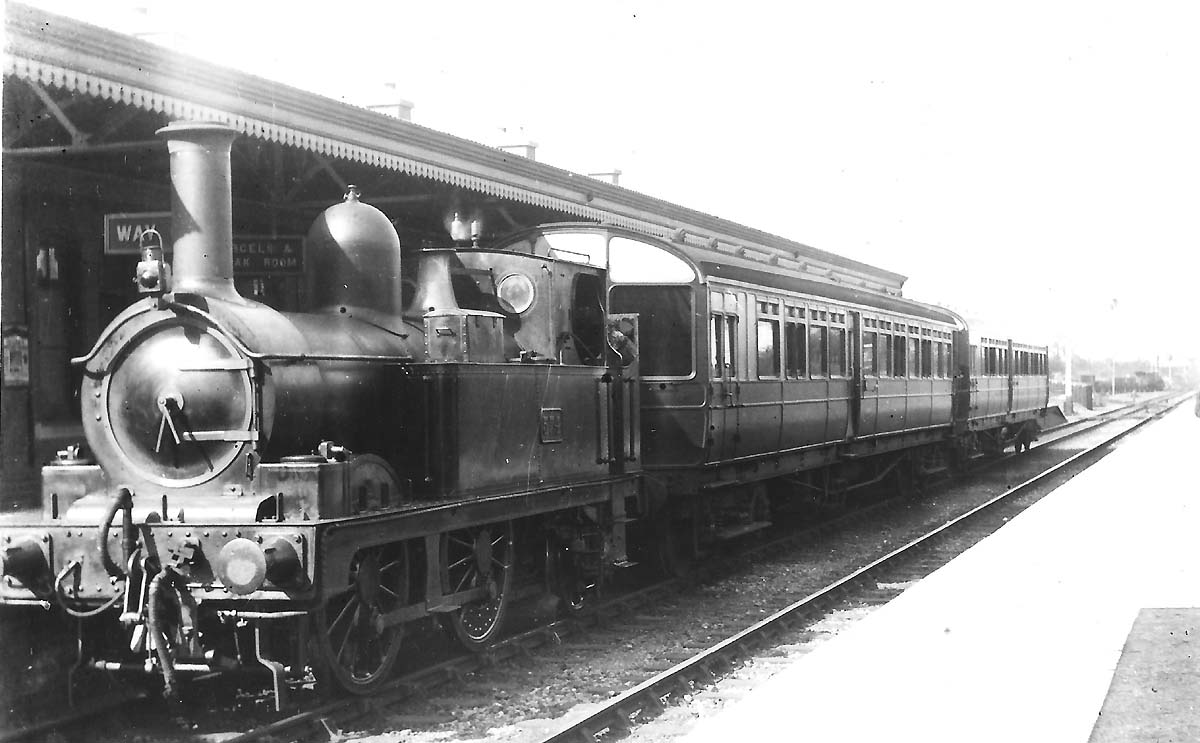 |
|
GWR Route: Banbury to Wolverhampton
Hall Green Station: gwrhg3895
 |
Great Western Railway 0-4-2T 517 class No 574 providing the
motive power behind a Rail Motor Car (Auto-train) service about to depart Hall
Green Up platform for Birmingham Moor Street circa 1914. At this time
Auto-trains were displacing the Steam Rail Motors (see 'gwrhg464a') from suburban passenger services on the
North Warwickshire Line. This was due to the increasing demand requiring more
passenger capacity as well as the increased flexibility of having a separate
locomotive. Auto-trains were powered by standard locomotives fitted with
special apparatus to allow the driver to operate the regulator and brake
controls remotely from the diving cab of a purpose built trailer coach, while
the fireman remained on the locomotive to service the fire. This meant that,
like the Steam Rail Motor, an auto-train could operate in either direction,
dispensing with the need for the locomotive to be ‘turned’ or even
‘run around’ at terminus stations. The regulator control was operated
via a mechanical rod linkage underneath the trailer coach, which could be
connected to an adapted locomotive. The tolerances of this mechanical
arrangement limited the maximum number of auto-trailers to two in the leading
direction. In addition to his fire and boiler duties, the Fireman had the
responsibility of re-establishing the brake's vacuum and operating the
reversing gear. Communication was therefore necessary between him and the
driver and an electric bell was provided. Specific instructions for working
auto-trains were established and those from the 1936 General Appendix to the
Rule Book can be found at 'Autocar
services'.
Locomotive No 574 was built in April 1870 at the Great
Western Railway’s Stafford Road Works in Wolverhampton as part of Lot H.
As originally constructed the locomotive was a 0-4-2T with a 7’4” +
7’4” wheelbase and side tanks with a total capacity of 620 gallons,
but in April 1897 longer frames (7’4” + 8’2” wheelbase)
were fitted at Swindon Works and this improved both the cab space and coal
bunker accommodation. It was recorded as diagram C. The maximum axle weight
after this alteration was 13tons, 2cwt, which allowed the locomotive access to
most of the company’s system (Route colour yellow). The tractive effort
with 150lb boiler pressure was 12,635lb, which placed the locomotive in the
Ungrouped Power classification. Sometime between 1906 and 1909, No 574 was
fitted with Auto-apparatus as it was recorded as operating Auto-trains while
allocated to Stourbridge shed (STB) in May 1909, but by January 1910, No 574
was allocated to Henley-in-Arden Shed. After a spell allocated to South Wales
sheds, No 574 was fitted with a Belpaire boiler operating at 165lb in August
1922. At the same time or soon after wider side tanks with a total capacity of
800 gallons were provided. The new boiler increased the locomotive’s
tractive effort to 13,900lb, while the other alterations increased the maximum
axle weight to 13ton, 10cwt, but the Route and Power classifications remained
unaltered. No 574 was finally withdrawn from Reading Shed (RDG) in February
1934
The two coaches seen here are both diagram L auto-trailers
on 9’ American bogies. These bogies were fitted to eighteen of the 70 foot
long diagram L auto-trailers during their construction between December 1907
and February 1908. These eighteen were built at Swindon Works under two lots;
1141 (numbers 53 to 58) and 1143 (numbers 59 to 70) for an average cost of
£1,261 each. The first diagram L auto-trailer had been built in 1906 and
eventually a total of thirty of this type were constructed (the largest
quantity of any auto-trailer type). Internally there were two third class
passenger compartments, either side of a central access vestibule. All the
doors were inward opening and slightly recessed. The larger compartment, which
was initially designated for forty-eight non-smoking passengers, had two open
saloon areas with longitude benches and a central area with three pairs of
transverse seating bays. The smoking compartment, which could accommodate
twenty eight passengers, was similarly arranged, but with only one open saloon
area containing two pairs of transverse seating bays. At this end was a good
sized luggage compartment, while at the other was the driver's vestibule. When
built, it was envisaged that only one auto-trailer would ever be required in a
train and the mechanical regulating gear was terminated at the drivers
vestibule position. After 1910 most auto-trailers were modified allowing the
coupling of a second auto-trailer with the diagram L auto-trailers having their
regulator rodding and electrical communication apparatus extended to the coach
end during 1913. In 27th March 1924, an accident occurred at Snow Hill, when a
three coach auto-train with 180 passengers slid on greasy rails and collided at
5 mph with the buffer stops at the end of bay platform No 4. The auto-train was
operating trailer first and the experienced driver had correctly applied both
the hand and vacuum brakes, but these were insufficient in the conditions and
the driver was not able to request his fireman (on the locomotive) to apply
sand to the rails to assist the braking. As a result of this accident sand
boxes were fitted to auto-trailers between 1927 and 1928. The
smoking/non-smoking compartments were reversed in August 1928 to reflect
changes in social preferences with the familiar triangular ‘No
Smoking’ sign being introduced in 1930. The diagram L auto-trailers were
all condemned in the 1950s.
The auto-trailers in the photograph are painted in the lined
chocolate and cream livery used between 1904 and 1908. After this date coaching
stock was painted all over brown until 1912, and then crimson lake until 1922,
before reverting back to chocolate and cream again, however the diagram L
auto-trailers were turned out in the chocolate and cream livery when new in
1908, so it is unlikely that they were scheduled for repainting for several
years.
Robert Ferris
 back back

|
